The Solar Reflective Glass Market is estimated to be valued at USD 5.2 billion in 2025 and is projected to reach USD 10.5 billion by 2035, registering a compound annual growth rate (CAGR) of 7.3% over the forecast period. The market follows a classic technology adoption lifecycle, driven by the global push for energy-efficient buildings, green construction, and the integration of renewable energy. From 2020 to 2024, the market is in the early adoption phase, expanding from USD 3.6 to 4.8 billion.
During this period, conventional low-emissivity (low-E) and tinted solar reflective glass dominate, analogous to “hydraulic” technologies-well-established, cost-effective, and widely used in commercial and residential construction. High-performance coatings and advanced laminated or multi-layered variants, comparable to those in the electric, hydraulic, and EPS segments, remain niche due to higher costs and limited awareness.
From 2025 to 2030, the market enters a scaling phase, growing from USD 5.2 billion to USD 7.4 billion. Adoption accelerates as governments and developers increasingly mandate energy-efficient building materials, and as electric, hydraulic-like innovations such as coated, tempered, and insulated reflective glass gain traction for enhanced solar control. EPS-like solutions, including smart or electrochromic reflective glass, are beginning to be deployed more broadly in high-value commercial and industrial projects.
Between 2030 and 2035, the market transitions to consolidation, reaching a value of USD 10.5 billion. Growth moderates as mainstream adoption saturates, conventional solar reflective glass remains dominant, and advanced smart solutions capture premium segments. The overall market maturity curve is sigmoid-shaped, reflecting early experimentation, rapid scaling, and eventual stabilization, with segments mapped according to technological complexity, cost, and readiness for adoption.
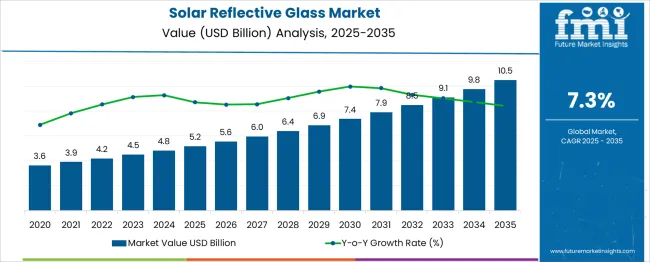
| Metric | Value |
|---|---|
| Solar Reflective Glass Market Estimated Value in (2025 E) | USD 5.2 billion |
| Solar Reflective Glass Market Forecast Value in (2035 F) | USD 10.5 billion |
| Forecast CAGR (2025 to 2035) | 7.3% |
The solar reflective glass market is experiencing notable growth due to its increasing relevance in sustainable architecture and green building initiatives. As global temperatures rise and urban energy demands intensify, reflective glazing solutions are being adopted to minimize solar heat gain while maintaining daylight visibility. The integration of solar control features within building facades has become a key design parameter across both residential and commercial infrastructures.
Technological advancements in vacuum deposition and magnetron sputtering have enabled the development of coatings that enhance thermal insulation while maintaining aesthetic appeal. Regulatory policies promoting zero-energy buildings and rising urbanization have further accelerated the uptake of reflective glass solutions.
Market momentum is being driven by strategic investments from construction majors, real estate developers, and facade engineering firms seeking to meet energy compliance certifications. Over the coming years, the combination of environmental regulations, cost optimization benefits, and aesthetic design integration is expected to drive continued growth of solar reflective glass adoption across developed and emerging economies.
The solar reflective glass market is segmented by coating type, application, glazing type, end-user, and geographic regions. By coating type of the solar reflective glass market is divided into Hard Coat Soft Coat. In terms of application of the solar reflective glass market is classified into Commercial Buildings, Residential Buildings, Automotive, Solar Power Generation Greenhouses. Based on glazing type of the solar reflective glass market is segmented into Double Glazing, Single Glazing Triple Glazing. By end-user of the solar reflective glass market is segmented into Construction, Automotive Solar Energy. Regionally, the solar reflective glass industry is classified into North America, Latin America, Western Europe, Eastern Europe, Balkan & Baltic Countries, Russia & Belarus, Central Asia, East Asia, South Asia & Pacific, and the Middle East & Africa.
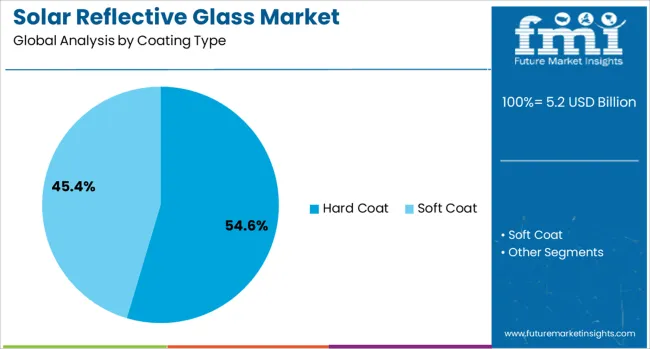
The hard coat segment is expected to account for 54.6% of the solar reflective glass market revenue share in 2025, making it the most dominant coating type. This position is being supported by the superior durability, scratch resistance, and cost-effectiveness offered by hard-coated reflective glass in comparison to soft-coated alternatives.
The production process of hard coat glass, involving pyrolytic deposition at high temperatures, has enabled stable coatings that can be easily handled and processed during fabrication. Its suitability for single glazing and compatibility with laminated safety glass has led to increased adoption in mid-rise commercial buildings and infrastructure projects.
The ability of hard coat reflective glass to retain performance even under harsh climatic conditions has been a significant factor in its use across regions with high solar intensity. As architects and builders prioritize both performance and ease of installation, the hard coat segment is expected to maintain its leadership in volume-driven projects demanding long-lasting thermal control solutions.
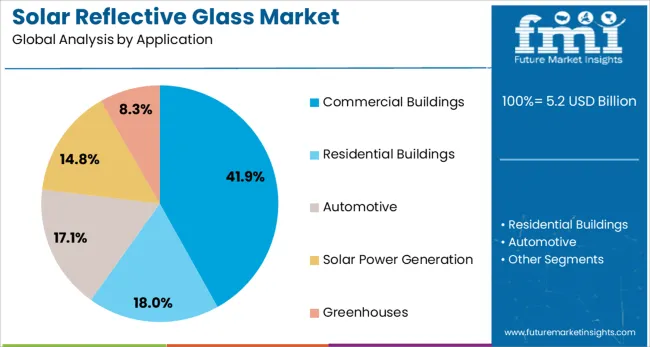
The commercial buildings segment is projected to hold 41.9% of the revenue share in the solar reflective glass market in 2025, reflecting its leading role in driving demand. Growth in this segment is being influenced by large-scale investments in office complexes, shopping malls, educational institutions, and healthcare facilities that require effective thermal insulation and glare control.
Solar reflective glass has been increasingly specified in green building certifications such as LEED and BREEAM, further driving its adoption in commercial infrastructure. Energy cost reduction, enhanced occupant comfort, and lower HVAC loads are among the key benefits prompting developers to incorporate reflective glass into new construction and retrofit projects.
The integration of double or triple-glazed reflective panels in curtain wall facades and skylights has also elevated the demand from architects seeking modern design without compromising energy performance. As governments and corporations adopt net-zero building strategies, the role of reflective glass in meeting energy performance benchmarks is expected to solidify its market share in the commercial sector.
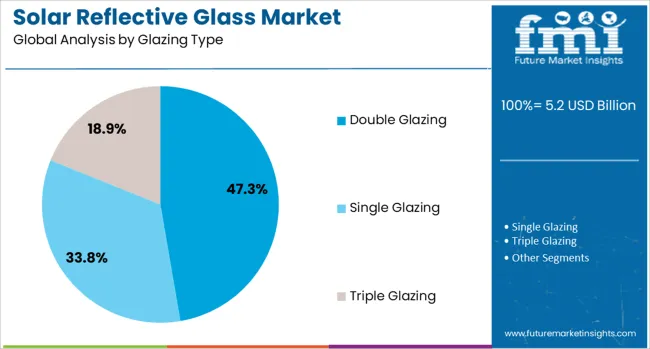
The double glazing segment is anticipated to command 47.3% of the solar reflective glass market revenue share in 2025, positioning it as the most widely used glazing configuration. This dominance is driven by the enhanced thermal insulation, acoustic control, and condensation resistance offered by double-glazed reflective units.
The combination of two panes with an inert gas-filled spacer has proven effective in reducing U-values, thereby supporting energy savings in temperature-controlled environments. The compatibility of double glazing with both hard and soft reflective coatings has enabled its use in a wide range of architectural applications, from corporate headquarters to hospitality structures.
Additionally, the performance of double glazing in meeting regional energy codes and building envelope standards has made it a preferred choice for developers targeting operational efficiency. As construction stakeholders increasingly emphasize lifecycle cost benefits and sustainable design, double-glazed reflective glass is expected to remain at the forefront of high-performance glazing solutions in the market.
The solar reflective glass market is expanding as building and automotive sectors prioritize energy efficiency and heat management. This glass reduces solar heat gain, improves indoor comfort, and lowers cooling energy consumption. Europe and North America lead due to stringent energy regulations, while Asia-Pacific shows rapid growth driven by urban infrastructure and automotive production. Manufacturers are focusing on coating technologies, durability, and aesthetic appeal. Increasing adoption in commercial buildings, residential projects, and vehicles is supporting consistent global market growth.
Solar reflective glass is widely used in commercial and residential buildings to reduce cooling loads and improve energy efficiency. By reflecting a portion of solar radiation, it minimizes heat transfer while maintaining natural light. Architects and developers are integrating it into curtain walls, facades, and skylights to meet energy codes and green building standards. Growing awareness of energy conservation and high electricity costs drive adoption. Builders prefer glass that combines aesthetic appeal with thermal performance, enabling sustainable, comfortable, and cost-effective indoor environments. This trend continues to fuel global demand in the construction and real estate sectors.
The automotive industry increasingly uses solar reflective glass to enhance passenger comfort, reduce air conditioning energy usage, and improve cabin aesthetics. Windshields, sunroofs, and windows with reflective coatings help maintain cooler interiors, particularly in regions with high solar exposure. OEMs are collaborating with glass manufacturers to provide lightweight, durable, and scratch-resistant solutions compatible with advanced vehicles. Rising electric vehicle adoption further emphasizes reducing cooling energy consumption, strengthening demand. Customizable coatings, tinted options, and enhanced visibility are attracting automakers, promoting growth in the solar reflective glass market within passenger and commercial vehicle segments.
Asia-Pacific dominates due to urban expansion, industrial growth, and rising automotive production. Europe and North America focus on high-performance glass for energy-efficient buildings and luxury vehicles. Regional growth is influenced by government building codes, renewable energy initiatives, and automotive climate control standards. Local production capabilities and import-export dynamics affect availability and cost. Emerging regions are gradually adopting reflective glass solutions to address rising temperatures, energy concerns, and modern architectural trends. Expanding construction projects, infrastructural investments, and automotive demand collectively drive consistent market growth across regions.
Manufacturers are partnering with construction companies, automotive OEMs, and coating technology providers to enhance product offerings and distribution. Alliances support development of advanced coatings, improved durability, and large-scale production for global projects. Collaborations with architects and designers help integrate reflective glass in building aesthetics while meeting performance requirements. Joint ventures and licensing agreements allow entry into emerging markets and compliance with regional regulations. By leveraging strategic partnerships, companies strengthen supply chains, boost market visibility, and accelerate adoption across construction, automotive, and industrial sectors worldwide.
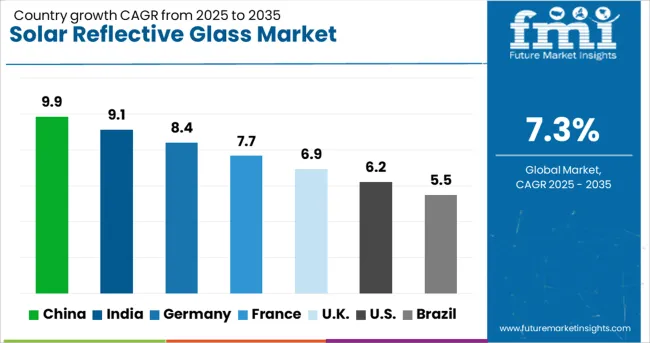
| Country | CAGR |
|---|---|
| China | 9.9% |
| India | 9.1% |
| Germany | 8.4% |
| France | 7.7% |
| UK | 6.9% |
| USA | 6.2% |
| Brazil | 5.5% |
The solar reflective glass market is projected to grow at a CAGR of 7.3%, driven by the demand for energy-efficient building materials and high-performance glazing solutions. China leads with a growth rate of 9.9%, fueled by large-scale construction projects and adoption of energy-conscious building codes. India follows at 9.1%, supported by government initiatives to enhance energy efficiency in residential and commercial infrastructure. Germany, growing at 8.4%, benefits from stringent energy regulations and advanced glass manufacturing capabilities. The UK, with a growth rate of 6.9%, adopts reflective glass in urban commercial and residential developments, while the USA, at 6.2%, integrates it in sustainable construction and retrofit projects. This report includes insights on 40+ countries; the top countries are shown here for reference.
China leads the solar reflective glass market with a 9.9% growth rate, driven by rapid urbanization, renewable energy adoption, and green building initiatives. Compared to India, China has a larger manufacturing base and advanced technological capabilities, enabling high-quality reflective glass production at scale. Demand is fueled by increasing installation of energy-efficient buildings, solar power projects, and automotive applications. Investments in R&D focus on improving reflectivity, durability, and environmental sustainability. Government policies promoting energy-saving construction materials further boost adoption. Expansion in commercial and residential infrastructure drives consistent market growth. Export opportunities to Asia-Pacific countries support revenue streams. Advanced manufacturing processes and emphasis on quality certification strengthen China’s leadership in the solar reflective glass market. Continuous innovation and integration with smart building technologies enhance product value and operational efficiency.
India’s solar reflective glass market grows at 9.1%, supported by renewable energy targets, green building projects, and increasing solar panel installations. Compared to Germany, India emphasizes cost-effective production while meeting efficiency standards. Growth is driven by residential, commercial, and industrial sectors seeking energy savings and reduced cooling costs. Manufacturers focus on high-reflectivity coatings, durability, and weather resistance. Government initiatives promoting energy-efficient infrastructure and solar rooftop programs further boost demand. Urban development and industrial expansion contribute to steady adoption. Investments in R&D aim to enhance optical performance, reduce production costs, and expand product applications. Export opportunities to neighboring countries increase market potential. Overall, India’s market benefits from a growing emphasis on sustainable construction, government support, and evolving consumer awareness regarding energy efficiency.
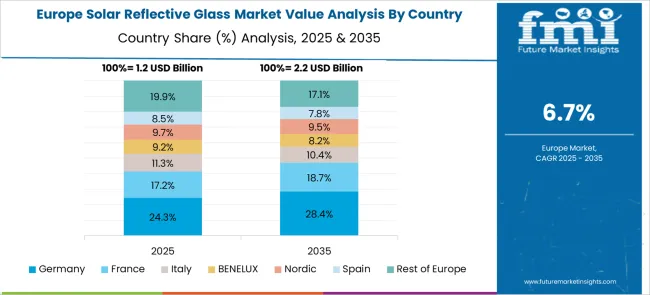
Germany’s market grows at 8.4%, driven by demand from energy-efficient buildings and solar power applications. Compared to the UK, Germany emphasizes high-quality production standards, material sustainability, and regulatory compliance. Manufacturers invest in coatings and advanced fabrication techniques to improve reflectivity and thermal insulation. Growth is fueled by government incentives for green construction and sustainable energy adoption. The commercial, residential, and automotive sectors adopt reflective glass solutions for energy savings and environmental benefits. Export demand within Europe further supports market expansion. Technological advancements enhance durability, weather resistance, and optical performance. Germany’s focus on sustainable practices, efficiency standards, and quality assurance ensures steady market growth and reinforces its position as a key player in the solar reflective glass industry.
The UK market grows at 6.9%, driven by green building initiatives, urban development, and solar energy integration. Compared to the US, the UK emphasizes strict quality standards, regulatory compliance, and environmentally friendly manufacturing processes. Demand arises from commercial, residential, and industrial sectors seeking reduced energy costs and sustainable construction solutions. Manufacturers focus on coatings, reflectivity, and thermal performance to meet efficiency requirements. Government policies promoting low-carbon buildings and renewable energy adoption boost market growth. Research investments aim to enhance durability, optical clarity, and energy efficiency. Export opportunities within Europe provide additional revenue streams. The UK market remains stable due to government support, technological innovation, and rising awareness of energy-efficient building materials.

The USA market grows at 6.2%, driven by adoption in commercial, residential, and solar energy applications. Compared to China, the USA emphasizes high-quality production, technological innovation, and sustainability standards. Growth is fueled by energy-efficient building programs, green construction initiatives, and environmental regulations. Manufacturers focus on reflective coatings, durability, and thermal performance to meet stringent efficiency criteria. Government incentives for renewable energy and low-carbon buildings boost market adoption. Research and development improve optical clarity, heat rejection, and lifespan. Export opportunities to neighboring countries further strengthen growth. Overall, the USA market benefits from rising awareness of energy savings, regulatory support, and technological advancements, ensuring steady expansion in the solar reflective glass industry.

The solar reflective glass market is increasingly shaped by performance-driven adoption in energy-critical infrastructure, with demand driven less by broad sustainability trends and more by precise thermal management needs and regulatory compliance for energy codes. In commercial offices, airports, and high-rise residential complexes, solar-reflective glass is being strategically deployed to reduce cooling loads by 15–25%, while improving occupant comfort through controlled daylighting and glare reduction. High-performance coatings, including low-emissivity and selective reflection layers, have become differentiators, with players competing on reflectance efficiency, optical clarity, and durability under high UV exposure.
Ravenbrick LLC leverages proprietary multilayer coatings to combine thermal reflection with aesthetic customization, targeting luxury residential and premium commercial projects. PPG Industries emphasizes scalable solutions suitable for large façade projects, focusing on integrated solar control films that allow retrofit applications and energy compliance for international building codes. e-Chromic distinguishes itself with adaptive glazing that modulates reflectivity in response to real-time solar intensity, enabling dynamic energy management in smart buildings. Guardian Industries and Asahi Glass (AGC Inc.) dominate in large-scale industrial and infrastructural deployments, offering high-durability reflective glass with proven optical stability in extreme environments. Heliotrope focuses on niche high-reflectivity coatings designed to meet stringent local heat-gain regulations in Middle East and Southeast Asia.
Innovation is concentrated on coating uniformity, hybrid reflective-tinted surfaces, and integration with automated building management systems, allowing global players to differentiate beyond standard energy efficiency. Market expansion is being accelerated by stringent energy codes, increasing capital allocation for smart buildings, and regulatory incentives for retrofitting existing structures, making competitive advantage reliant on technical precision, application versatility, and regional service footprint rather than price alone.
| Item | Value |
|---|---|
| Quantitative Units | USD 5.2 Billion |
| Coating Type | Hard Coat and Soft Coat |
| Application | Commercial Buildings, Residential Buildings, Automotive, Solar Power Generation, and Greenhouses |
| Glazing Type | Double Glazing, Single Glazing, and Triple Glazing |
| End-User | Construction, Automotive, and Solar Energy |
| Regions Covered | North America, Europe, Asia-Pacific, Latin America, Middle East & Africa |
| Country Covered | United States, Canada, Germany, France, United Kingdom, China, Japan, India, Brazil, South Africa |
| Key Companies Profiled | RavenbrickLLC, PPGIndustries, e-Chromic, GuardianIndustries, Heliotrope, AsahiGlass, and Gentex |
| Additional Attributes | Dollar sales in the Solar Reflective Glass Market vary by type including coated glass, tinted glass, and reflective films, application across residential, commercial, and automotive sectors, and region covering North America, Europe, and Asia-Pacific. Growth is driven by increasing energy-efficient building construction, demand for thermal insulation, and rising adoption of sustainable architectural solutions. |
The global solar reflective glass market is estimated to be valued at USD 5.2 billion in 2025.
The market size for the solar reflective glass market is projected to reach USD 10.5 billion by 2035.
The solar reflective glass market is expected to grow at a 7.3% CAGR between 2025 and 2035.
The key product types in solar reflective glass market are hard coat and soft coat.
In terms of application, commercial buildings segment to command 41.9% share in the solar reflective glass market in 2025.
Explore Similar Insights

Thank you!
You will receive an email from our Business Development Manager. Please be sure to check your SPAM/JUNK folder too.
Chat With
MaRIA